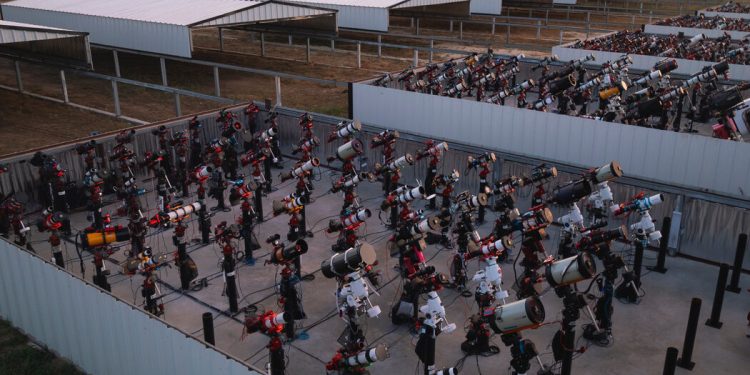By day, this sparsely populated patch of Central Texas land is unremarkable. Eleven buildings, almost identical, look like bland, oversized hangars. Several large motorhomes are parked nearby.
Not so long ago, cows grazed here.
But when the sun sets on a clear day, the buildings groan and creak as the roof of each shed recedes, like the sliding lid of a wooden crate.
In the hangars are hundreds of telescopes, which intermittently contract and pirouette, an army of robots awakening. Their owners cannot be found.
This is the Starfront Observatories. If you want to explore the universe but don’t want to go out, this might be the place for you. In the age of digital cameras and advanced Internet, amateur astronomy can now become a remote-controlled and much more sophisticated hobby.
Today’s telescopes offer much more than a magnified view of the night sky. For many practitioners, the name of the game is astrophotography: taking stunning long exposure photographs of objects too dark to see with the naked eye.
“It’s the most efficient way to do astronomy,” said Dustin Gibson, one of the company’s founders.
The romantic idea of an astronomer traveling to the top of a distant mountain to observe the universe through the eyepiece of a telescope has faded for decades. Today, many professionals set up observation campaigns from their own offices, sometimes on the other side of the world. The next morning, they go to work and check out the new images and data waiting for them on their computer.
This trend has also affected amateurs, with the appearance of remote observatories in Utah, New Mexico, Chile and elsewhere. But these are largely aimed at the more obsessed enthusiasts, who seek out the brightest and darkest skies for big, expensive, high-end gear.
Mr. Gibson and the company’s three other founders – Bray Falls, Nathan Hanks and Josh Kim – wanted to build something more people could afford. Since opening just over a year ago, Starfront has grown rapidly and is now home to more than 550 telescopes. It is, by far, the best installation of its type in the world, the company claims.
The telescopes include tiny telescopes that look like security cameras, as well as a monster with a two-foot-wide mirror owned by Mr. Gibson.
“Our mission is to make space exploration, and space in general, more accessible to everyone,” Mr. Kim said.
In the future, the founders envision schools and universities installing or renting time on telescopes at Starfront, allowing students to explore the universe.
“It becomes a place in their mind, instead of just things in a textbook,” Mr. Gibson said.
The sky has long attracted enthusiastic amateur observers, who are often the first to spot comets, exploding stars and other cosmological discoveries.
But it’s not a cheap hobby – a good telescope can cost hundreds or thousands of dollars – nor is it an easy hobby. Most people live in urban and suburban areas where the night sky, flooded with artificial lighting, never gets very dark. Clouds can also be a nuisance, and in some northern areas, staying outside in winter can be uncomfortably cold.
“It’s very difficult if your experience is going to depend on taking the system out somewhere and waiting for clear skies and hoping for the best,” Mr Gibson said.
Many beginners give up quickly, the telescope languishing in a cupboard.
Starfront’s founders say there’s a better solution: shipping the telescope to Texas, along with a digital camera and computer. At Starfront, a technician will install the device on a steel stand in one of the hangars.
It’s like renting a parking space for your telescope, even if it has a high-speed data connection. Cost starts at $99 per month for the smallest telescope.
Telescopes can track the same part of the sky over several nights. During this period, digital camera sensors can collect enough photons to reveal objects that would otherwise be invisible. Amateurs generally use telescopes with a wide field of view and thus spot objects missed by giant professional observatories, which focus on a point in the night sky.
“This is a nebula that I discovered in Virgo,” Mr. Falls said, pointing to a colorful image of a remnant of a supernova explosion in the constellation Virgo that rivaled the neighboring moon in size.
Mr Falls, an accomplished photographer of the night sky, said the image took about 180 hours of exposure.
“Most of the objects I look at are bigger than the moon in this sky, but they’re so faint that people don’t photograph them at all,” Falls said.
The four founders of Starfront had crossed paths through various previous business ventures and had a common interest in astronomy. Mr. Gibson, Mr. Hanks and Mr. Kim had all worked at a startup, OurSky, which provides a software development platform for spatial data applications. Mr. Falls and Mr. Gibson have known each other for years through the astrophotography community.
A few years ago, they started looking for a site. There were obvious requirements.
It must have been dark: class 1, the darkest on the Bortle scale, named after John Bortle, the amateur astronomer who created it. (Times Square in Manhattan is a 9, the brightest and least desirable for observing the cosmos.)
The weather was also expected to be clear most nights.
Texas was not an obvious choice. Deserts or mountain peaks in places like New Mexico and California can be darker and lighter. But 15 acres of land next to a dirt road near the tiny community of Rockwood offered other benefits, like fiber-optic cables that provided fast, reliable Internet access.
Rockwood isn’t completely in the middle of nowhere either. Austin and Fort Worth are less than a three-hour drive away.
They purchased the land in April last year. As they began construction on the first hangar to house the telescopes, a rare torrential downpour made the Rockwood location seem like a terrible decision.
“They had what they said was the worst rain in about 20 years the day we arrived,” Mr. Gibson recalls. “It was a nightmare scenario. And all the water created insect problems.”
The rain has stopped. The floodwaters have drained away. They built the first two hangars.
On YouTube, Mr. Falls has posted videos explaining the concept of Starfront. That caught the attention of people like Jonathan Semeyn, who lives in Kansas, near downtown Kansas City. “The conditions I have for doing astrophotography are not great,” he said. “I have a very small garden with a limited view of the sky.”
Mr. Semeyn said he logs into his telescope every evening when the skies are clear over Texas. By the second half of last year, it had more than 800 hours of imaging on its telescope at Starfront. For a telescope he has at home, he said, he had maybe 100 hours so far this year. “It’s not a comparison,” he said.
Starfront worked with its customers to adapt the telescopes for remote observations. Carlos Garcia had purchased a Seestar S50, a small telescope controlled by a smartphone application.
He said he enjoyed using it, but “I found myself frustrated that here in Miami, where I live, I could only get it out, maybe, if I was lucky, two nights a week.”
He began contacting distant observatories. “The overwhelming reaction was, ‘You’re kidding, right? It’s a $500 telescope. It’ll never work,'” Mr. Garcia said. And the lowest rate he found was $800 a month.
When he heard about Starfront, he signed up for the cheapest option, $149 per month, and shipped the telescope to Texas.
Mr. Garcia made a video explaining how he set up and controlled his Seestar using a Mac. These small telescopes now represent a significant part of Starfront’s business. In newer hangars, a row of Seestars can be installed on a steel beam at the front of the building, providing an even cheaper mounting option at $99 per month.
Starfront recently purchased an adjoining 20 acres of land, providing room for many more hangars and telescopes. She is studying the possibility of a second site in the southern hemisphere.
As people sent their telescopes to Starfront, the founders struggled to keep up with customer support.
“We were drowning,” Mr. Kim recalled.
So they created a community on Discord, the instant messaging platform, so customers could help each other. Anyone can participate, not just people with telescopes at Starfront. This grew into a dynamic group of people helping to solve technical problems and collaborating to combine data from multiple telescopes to produce better images.
“You have 2,000 astronomy enthusiasts in one place, all talking about the same thing,” Gibson said.
“And they’re hilarious,” Mr. Kim added.









